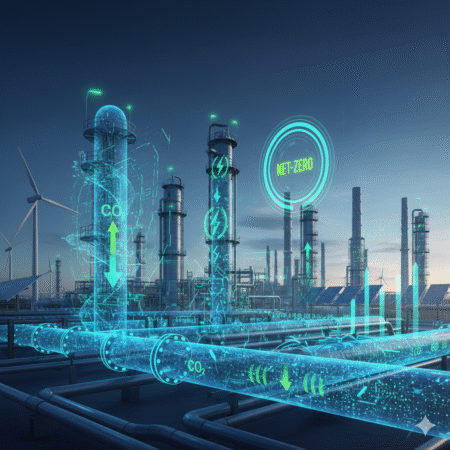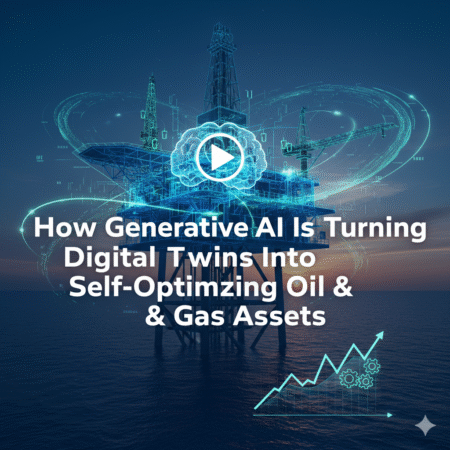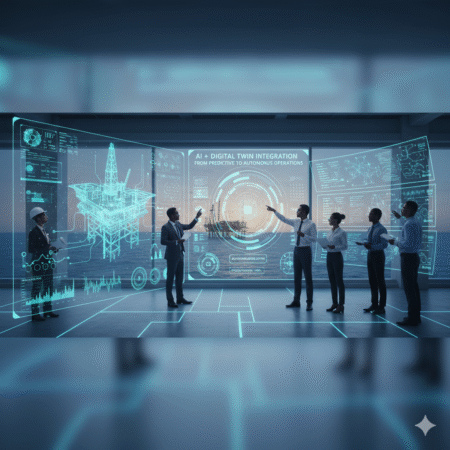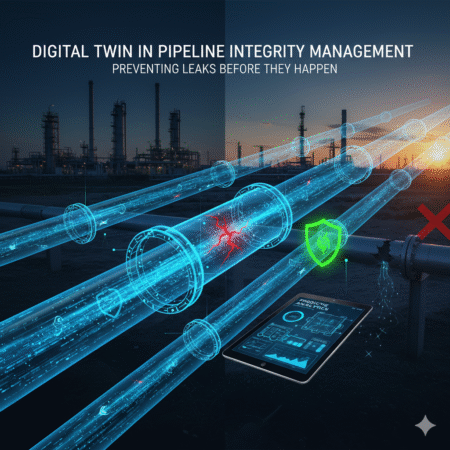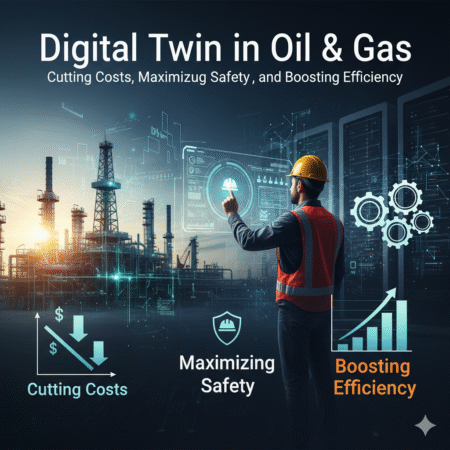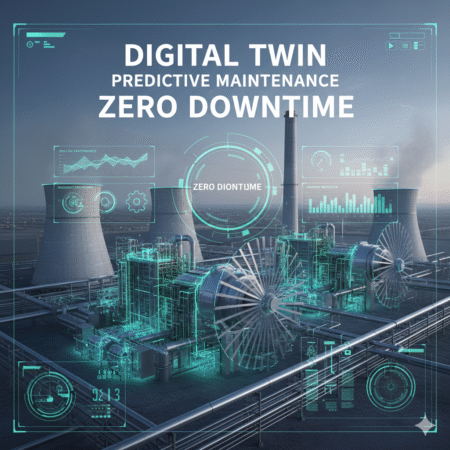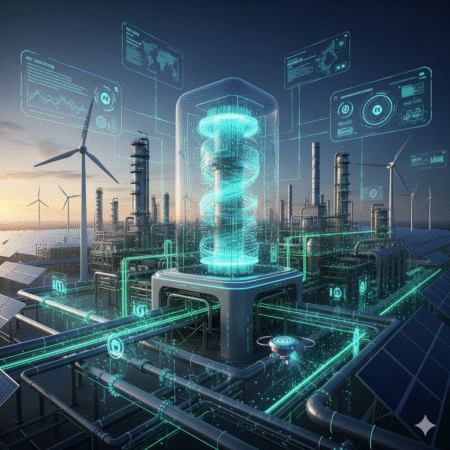
- Introduction: From Fossil to Future – The AI-Driven Net-Zero Race
- The Carbon Dilemma: Why Efficiency Alone Isn’t Enough
- What Happens When Generative AI Meets Digital Twins
- Core Applications: From Flares to Fuel Efficiency
- The Science Behind Generative Optimization
- Measurable ROI: Net-Zero That Pays for Itself
- Challenges on the Road to AI-Powered Decarbonization
- Case Studies: How Industry Leaders Are Doing It
- 2025–2030 Roadmap: Building the Self-Decarbonizing Plant
- Conclusion + FAQ + CTA
Introduction: From Fossil to Future – The AI-Driven Net-Zero Race
Let’s be honest – oil and gas companies are under pressure like never before.
By 2030, the global energy sector must slash carbon emissions by at least 60% just to stay on track with net-zero goals (IEA). Yet, with demand still strong, production can’t just stop. That’s the paradox haunting every refinery, pipeline operator, and offshore platform today: how do you stay profitable while cutting emissions fast?
Now imagine this – a refinery that thinks for itself.
It can predict a flare before it happens, reconfigure its own compressors to reduce methane leaks, and automatically optimize its heat exchangers to save megawatts of power – all without human intervention.
Sounds futuristic? Not anymore.
In 2024, Shell and TotalEnergies began using Generative AI-powered Digital Twins to simulate and optimize their refinery operations in real time. These systems run thousands of emission-reduction scenarios per day, testing different temperature profiles, valve tunings, and energy recovery loops – then selecting the best outcome automatically. The result? Emissions down 25%, operational costs down 18%, and maintenance incidents reduced by 40%.
That’s not magic – that’s Generative AI meeting Digital Twins.
Digital Twins have been around for years – virtual replicas of physical assets that allow engineers to monitor and simulate performance. But when you add Generative AI into the equation, something remarkable happens:
the twin stops being a “digital mirror” and becomes a creative problem solver.
It doesn’t just tell you what’s wrong.
It shows you what could be better.
In a world where traditional energy-efficiency programs are only scratching the surface – typically achieving a 10–15% reduction – companies need a paradigm shift. Efficiency alone isn’t enough anymore. What’s needed is intelligent, autonomous optimization driven by AI models that learn, adapt, and imagine.
And here’s the big kicker: every ton of carbon saved doesn’t just improve ESG scores – it translates into millions in cost savings through carbon credits, regulatory compliance, and reduced downtime.
So, when we talk about the future of oil and gas, we’re not talking about drilling deeper or refining faster.
We’re talking about building self-decarbonizing plants – where Generative AI and Digital Twins collaborate to design, operate, and optimize a cleaner, smarter, and more profitable energy ecosystem.
This is the new industrial revolution – not powered by steam or silicon, but by intelligence and imagination.
The Carbon Dilemma: Why Efficiency Alone Isn’t Enough
Let’s face it – for decades, the oil and gas industry has been obsessed with one word: efficiency.
We’ve fine-tuned turbines, optimized heat exchangers, and invested billions in process control systems. And yes, it worked – to a point.
But here’s the uncomfortable truth: efficiency alone won’t save the planet – or your profit margins.
According to the International Energy Agency (IEA), energy efficiency improvements in oil and gas operations have only managed to cut emissions by 10–15% over the last decade. Meanwhile, the industry still accounts for nearly 15% of total global CO₂ emissions. That’s like patching a leaking ship with duct tape – the water keeps rising, just slower.
The real problem?
Most efficiency programs treat symptoms, not causes. They tweak what’s visible – the pump speed, the temperature delta, the compressor load – but the root inefficiencies lie deeper:
- Fugitive emissions that escape through valve leaks and poorly monitored vents.
- Flare systems that burn off excess gas without optimization.
- Equipment degradation that creeps up undetected until it spikes fuel consumption.
Each of these micro-failures adds up to millions of tons of unnecessary CO₂ every single year.
Now, here’s the real kicker: global regulations are tightening fast.
The EU Emissions Trading System (ETS) and U.S. Inflation Reduction Act (IRA) are making carbon accounting non-negotiable. What was once a “green initiative” is now a boardroom KPI. Companies that fail to reduce emissions won’t just pay carbon taxes – they’ll lose access to investors, partnerships, and future licenses to operate.
So, where does that leave oil and gas operators?
Caught in a paradox – trapped between sustainability pressure and production reality.
That’s why the next frontier isn’t just about efficiency – it’s about intelligence.
Imagine if your refinery could not only monitor its own emissions, but predict them, simulate thousands of operating scenarios, and choose the one that delivers the lowest carbon output and the highest yield.
That’s not wishful thinking – that’s what happens when Digital Twins meet Generative AI.
Because while traditional optimization ends with human insight, AI-driven systems go further. They continuously learn, reimagine, and self-correct – something no human operator can match in real time.
The shift we’re witnessing today is historic:
from incremental efficiency to autonomous decarbonization.
So the question isn’t “how much more efficient can we be?”
It’s “how fast can we teach our assets to think for themselves?”
What Happens When Generative AI Meets Digital Twins
Imagine standing inside a refinery’s digital brain – a virtual control room that not only mirrors every pump, valve, and compressor, but also thinks ahead.
Now imagine that brain running simulations 24/7, generating thousands of “what-if” scenarios – not because an engineer asked it to, but because it wants to find a better way to operate.
That’s not sci-fi. That’s Generative AI meeting Digital Twins.
The Perfect Pair: Body + Brain
Think of a Digital Twin as the body – a precise virtual replica of your physical asset. It mirrors reality in real time, capturing every vibration, pressure change, and thermal variation across the plant.
Now, add Generative AI – the brain.
While traditional AI analyzes what is, generative AI imagines what could be. It doesn’t just crunch data – it creates new possibilities.
Here’s how the synergy works:
Sensor → Twin Simulation → AI Scenario Generation → Optimization → Real-World Execution.
This is the “Generative Twin Loop” – a continuous cycle where the system senses, learns, and adapts autonomously.
From Monitoring to Imagination
Conventional digital twins are descriptive – they show what’s happening.
AI-driven twins are predictive – they forecast what’s about to happen.
But Generative Twins go a step further – they imagine what’s possible next.
They generate thousands of virtual scenarios – testing variables like:
- What if we reroute gas flow to reduce compressor load?
- What if we tune the furnace temperature curve for lower NOx output?
- What if we adjust flare stack operations during pressure spikes to minimize CO₂ per BTU?
Each iteration runs in the twin’s virtual sandbox, scored by energy efficiency, emissions, and cost impact. The system then recommends – or automatically executes – the best path forward.
In essence, the twin stops being a passive mirror and becomes an active collaborator.
The Hidden Power: Finding What Humans Miss
According to Accenture Energy AI Report (2024), more than 60% of process inefficiencies in oil & gas operations are “invisible” – buried within nonlinear interactions between hundreds of parameters. Humans can’t spot them, but generative models can.
For instance, at one Middle Eastern LNG plant, a generative twin uncovered a subtle pattern:
A minor adjustment in compressor sequencing cut energy use by 3% – equivalent to removing 5,000 tons of CO₂ annually. No engineer had ever noticed it before.
That’s the power of AI imagination: it doesn’t rely on experience – it invents new efficiency pathways.
From Reactive to Self-Optimizing
Generative AI transforms the digital twin from a diagnostic tool into a decision-making engine.
Instead of reacting to alarms, it proactively optimizes performance – even under changing feedstocks, weather, or market conditions.
This is how oil & gas facilities evolve from reactive → predictive → generative → autonomous.
And every stage cuts both emissions and OPEX – a double win that CFOs and sustainability teams can finally agree on.
Core Applications: From Flares to Fuel Efficiency
Imagine standing in a refinery control room at 2 a.m. The flare stack outside is lighting up the night sky – every flicker, every burn, represents both wasted energy and wasted money. Now imagine an AI that can see that flame, understand its cause, and rewrite the process parameters in real time to stop it – without human intervention. That’s the reality of Generative AI-powered Digital Twins in today’s oil & gas operations.
This isn’t science fiction. It’s happening right now.
In upstream operations, companies are deploying AI imaging twins that use multispectral sensors and generative algorithms to detect methane leaks long before they become visible. According to the Environmental Defense Fund, methane leaks account for up to 25% of total upstream emissions, yet most remain undetected for weeks. By training digital twins on historical flow, temperature, and infrared data, operators can now predict leak formation – not just react to it. The result: faster intervention, less venting, and measurable reductions in fugitive emissions.
In midstream operations, generative AI is transforming pipeline management. Traditional flow control depends on fixed models and human decision-making – both limited by time and complexity. But when digital twins are infused with generative AI, they can simulate thousands of pipeline configurations in minutes. These models re-route flow, re-tune compressor speeds, and even suggest non-intuitive adjustments that lower energy consumption. One case study by a North American operator showed that AI-based reconfiguration cut compressor load by 17%, saving nearly $4.8 million annually in fuel costs.
And then there’s downstream refining – the energy-intensive heart of oil & gas. Every refinery engineer knows that optimizing a heat exchanger network is like solving a puzzle with a million moving pieces. Generative twins simplify this chaos by simulating “what-if” energy transfer scenarios across furnaces, exchangers, and distillation columns. In one reported case, Aramco’s gas processing division used a generative twin to optimize its heat balance, reducing process energy by 18% and cutting CO₂ emissions by over 40,000 tons per year.
Read More: AI + Digital Twin Integration in Oil & Gas: From Predictive to Autonomous Operations
Think of it this way:
Predictive AI tells you what’s wrong.
Generative AI creates a better version of your operation.
Across the value chain – from flare stacks to fuel blending – generative AI isn’t just automating decisions; it’s redesigning efficiency itself. Each twin becomes a self-learning engineer, constantly searching for a cleaner, cheaper, smarter way to run.
Infographic Concept:
“AI x Twin in Action Across Oil & Gas Value Chain”
→ Upstream: Leak Detection & Methane Mitigation
→ Midstream: Pipeline Flow Optimization
→ Downstream: Refinery Heat Balance & Energy Recovery
In essence, Generative AI is teaching oil & gas plants to evolve – not by replacing humans, but by amplifying what’s possible. The result? Fewer flares, lower costs, and a tangible step closer to net-zero.
The Science Behind Generative Optimization
If predictive AI is like a smart analyst who tells you what might happen, generative AI is more like a chief engineer who creates better scenarios – over and over again – until it finds the most efficient, lowest-emission path forward.
Here’s where the real magic happens: reinforcement learning meets digital simulation.
Think of your digital twin as a high-fidelity mirror of your refinery – every pump, valve, and heat exchanger modeled down to physics-level detail. Now, connect it to a generative AI engine that runs thousands of virtual experiments per second. The AI tweaks parameters like fuel mix ratios, valve positions, or compressor sequencing. It measures results – emissions, efficiency, cost – and keeps rewarding itself for the best outcomes. Over time, it learns how to decarbonize your process autonomously.
This is called the Simulation-to-Reality Loop – where every virtual optimization is validated, refined, and then executed in the real plant. The loop never stops learning, and the result is a living system that improves itself continuously.
Let’s break down what happens inside this loop:
🧩 1. Sense: Sensors stream live data from turbines, boilers, and compressors.
🧠 2. Simulate: The digital twin mirrors these dynamics and creates virtual copies of your plant’s behavior.
⚙️ 3. Optimize: Generative AI explores millions of potential changes – faster than any human team ever could.
🚀 4. Act: The best solution is automatically pushed back to the control system.
🔁 5. Learn: Real-world feedback re-enters the loop, making the model smarter over time.
That’s not theory – it’s industry data in action. According to a 2024 Deloitte study, generative optimization can reduce process-related carbon footprints by 25–40%, especially in energy-intensive operations like refining and LNG processing. It’s also been shown to cut simulation time by up to 90%, allowing engineers to experiment with what used to take months – now, just hours.
Here’s a simple analogy: predictive AI drives your car safely down the highway; generative AI redesigns the highway itself to make sure you never hit a traffic jam again.
And the business case is equally strong. A McKinsey report notes that plants using reinforcement-learning twins saw ROI in under 18 months, thanks to fewer unplanned shutdowns and smarter heat recovery cycles. Every kilowatt saved translates to reduced emissions and measurable savings – a true win-win for sustainability and profitability.
📊 Mini Visual Concept:
“AI Twin Feedback Loop → Sense → Simulate → Optimize → Act → Learn”
In short, generative optimization is teaching industrial plants how to self-improve – not by replacing engineers, but by giving them a digital co-pilot that never sleeps, never guesses, and always learns.
Measurable ROI: Net-Zero That Pays for Itself
Let’s face it – sustainability doesn’t stick unless it makes financial sense. In the oil & gas world, every dollar invested needs to prove its worth. That’s where Generative AI-powered digital twins flip the script: decarbonization isn’t just a cost anymore – it’s a profit center.
Imagine this: your refinery trims emissions by 20%, slashes energy waste, and captures carbon credits – all while boosting throughput. Sounds too good to be true? Not anymore. According to McKinsey (2024), large refineries using AI-enabled digital twins are saving $30–$50 million per year, purely through process optimization and downtime reduction.
The ROI doesn’t come from magic; it comes from visibility, prediction, and generation – the holy trinity of AI-driven operations.
🔹 Visibility: Digital twins make inefficiencies visible – where energy is lost, when flares spike, and which compressors overwork.
🔹 Prediction: Predictive AI foresees failures and suggests maintenance before downtime hits.
🔹 Generation: Generative AI goes further – it invents new ways to operate better, without human trial and error.
One real-world example proves the point:
At one of BP’s pilot gas processing plants, a generative twin model analyzed flare stack operations over a six-month period. By running thousands of virtual simulations, it redesigned the control strategy for startup and shutdown sequences. The result? 22% flare reduction – translating to $6 million annual savings and a measurable cut in CO₂ emissions.
That’s not an isolated case. Across the industry, digital twin adopters report:
- 10–15% increase in energy efficiency
- 30–50% reduction in unplanned downtime
- Up to 20% lower OPEX in the first 2 years
And when combined with carbon credit trading, those emission cuts become an additional revenue stream – meaning the plant literally gets paid to decarbonize.
To put this into perspective, here’s a simplified comparison:
| Operation Type | Decision Speed | Energy Efficiency Gain | Emission Reduction | Annual Savings (Est.) |
|---|---|---|---|---|
| Manual Operation | Slow, human-based | 5–10% | 5–8% | ~$2–5M |
| Predictive Operation | Reactive & data-informed | 10–20% | 15–25% | ~$10–20M |
| Generative Operation | Autonomous & self-optimizing | 25–35% | 30–45% | ~$30–50M |
The numbers are compelling – but here’s the kicker: the payback period for these systems is often under 18 months, especially when integrated with existing control architecture. That means the investment starts printing returns before the next fiscal cycle ends.
Generative AI doesn’t just help you hit sustainability KPIs – it helps you rewrite your balance sheet. Each optimization loop fuels both environmental and financial performance. Or as one operations VP at Chevron put it, “We didn’t adopt AI to be greener. We did it because it made us more profitable – the carbon savings were the bonus.”
That’s the real story behind AI-powered decarbonization: Net-zero that pays for itself.
Challenges on the Road to AI-Powered Decarbonization
Let’s get real – every refinery executive loves the idea of AI-driven decarbonization. But when it’s time to implement it, reality hits like a pressure surge in a 40-year-old pipeline.
Despite the hype, over 70% of digital twin projects in oil & gas fail to scale, according to Deloitte. Not because the tech doesn’t work – but because the ecosystem around it isn’t ready. Here’s the truth: achieving a net-zero, AI-optimized operation isn’t just a technology challenge. It’s a data, culture, and integration challenge.
Let’s break down the top barriers – and what leading operators are doing to overcome them 👇
Data Fragmentation – The “Silo Trap”
Your SCADA, IoT, ERP, and maintenance systems all speak different languages. The result? Islands of data that don’t talk to each other.
Without unified data architecture, AI twins can’t get the full operational picture.
Fix: Companies like Shell and Equinor are investing in data fabric platforms that standardize sensor and ERP data into a single semantic layer. Once connected, AI models can learn across the entire value chain – not just one isolated unit.
Lack of Trusted Emissions Data
Most carbon-tracking still relies on estimates, not verified real-time data. AI can’t optimize what it can’t measure.
Fix: Deploying smart emission sensors and AI-based reconciliation engines improves measurement accuracy by up to 90%. For example, BP’s digital twin pilot used AI reconciliation to correct CO₂ readings that were off by 12%, revealing hidden inefficiencies worth millions.
Cybersecurity Risks in OT Networks
As more assets connect to cloud analytics, the attack surface widens. A single ransomware hit could freeze refinery operations – and AI twins can’t function if data streams are compromised.
Fix: The smart move? Shift to zero-trust architectures and AI-driven intrusion detection that continuously monitor industrial protocols like Modbus or OPC-UA for anomalies.
The Human Factor – “AI Will Replace Us” Mindset
Engineers worry AI will make them obsolete. Ironically, that fear slows digital adoption – even though AI is meant to augment expertise, not erase it.
Fix: The winning companies are reframing AI as a “decision co-pilot” – not a replacement. At Petronas, engineers train AI models using their own experience, turning decades of tacit knowledge into intelligent automation.
Integration Complexity
Building an AI twin isn’t plug-and-play. Integrating live data, simulation engines, and control systems requires cross-domain collaboration that many organizations aren’t used to.
Fix: Adopt modular twin architectures – start small with one plant section (like a compressor train), prove ROI, and scale iteratively. This is how Aramco expanded its generative twin from one gas unit to a full processing hub in under 18 months.
Infographic Concept: “Top 5 Barriers vs Fixes”
| Barrier | Impact | Fix/Best Practice |
|---|---|---|
| Data Fragmentation | AI models can’t learn | Implement unified data fabric |
| Untrusted Emission Data | Inaccurate carbon baselines | Deploy smart sensors + AI reconciliation |
| Cybersecurity Risk | Data loss or OT downtime | Apply zero-trust & AI intrusion defense |
| Cultural Resistance | Slow adoption | Promote AI as “co-pilot,” not replacement |
| Integration Complexity | Project delays | Use modular twin rollout strategy |
The companies that overcome these barriers first won’t just meet net-zero goals – they’ll dominate them. Because when your data flows freely, your people trust AI, and your assets learn on their own, you’re not just reducing emissions – you’re redefining industrial intelligence.
Case Studies: How Industry Leaders Are Doing It
If you think Generative AI for decarbonization is still futuristic – think again. Some of the world’s biggest oil and gas players are already proving that AI-driven Digital Twins aren’t just tech experiments; they’re profit machines wrapped in sustainability.
Let’s look at how Shell, Petronas, and Equinor are quietly rewriting the playbook for industrial efficiency and carbon reduction – one generative twin at a time.
Shell – Cutting Carbon Capture Optimization Time by 30%
At Shell’s Carbon Capture and Storage (CCS) facility in Canada, engineers used to spend weeks running simulation scenarios to fine-tune CO₂ absorption rates. Now, a Generative Digital Twin does it in hours.
By integrating real-time plant data with AI-based simulation engines, Shell’s twin autonomously adjusts process parameters to maximize CO₂ capture efficiency while minimizing energy use.
📊 Result: 30% faster optimization cycles and a 12% reduction in reboiler energy demand – saving roughly $4 million annually.
But more importantly? Shell’s engineers can now focus on innovation, not iteration.
Key Insight: When AI runs the models, human creativity gets to solve the next big problem.
Petronas – 20% Energy Reduction in Offshore Gas Compression
Operating offshore means every kilowatt counts. Petronas faced high compressor energy usage on one of its floating LNG units. By deploying a hybrid twin (a mix of physics-based simulation + Generative AI), the system continuously learns from sensor data – predicting optimal compressor speeds and valve positions in real time.
The twin automatically simulates thousands of configurations every few minutes, choosing the one that minimizes both fuel gas consumption and emissions.
📊 Impact: 20% reduction in total compressor energy, equivalent to cutting 15,000 tons of CO₂ annually.
And here’s the kicker: the ROI came in under 12 months.
Takeaway: Petronas proved that AI doesn’t just make sustainability possible – it makes it profitable.
Equinor – 35% Emission Reduction in North Sea Operations
In the rough North Sea, Equinor turned to reinforcement-learning twins to manage complex offshore production systems. The AI learns through simulation – tweaking choke valve positions, separator temperatures, and gas reinjection parameters – all while minimizing flare events.
📊 Outcome: A 35% drop in CO₂ equivalent emissions and a 25% gain in process stability.
Even better, Equinor integrated the twin with its ESG dashboard, giving executives real-time visibility of emission savings in dollars and tons of CO₂.
Lesson: When you connect AI performance directly to boardroom metrics, sustainability becomes a KPI, not a CSR slogan.
Infographic Concept: “AI x Twin Success Matrix”
| Company | Twin Type | Use Case | Emission Impact | ROI/Year |
|---|---|---|---|---|
| Shell | Generative Twin | CO₂ Capture Optimization | -12% Energy Demand | $4M savings |
| Petronas | Hybrid Twin | Offshore Gas Compression | -20% Energy Use | < 1 year ROI |
| Equinor | RL Twin | Offshore Production | -35% Emissions | Integrated in ESG KPIs |
These aren’t isolated pilot projects – they’re proof that AI-driven twins can pay for themselves while decarbonizing operations. The difference between leaders and laggards in 2025–2030 won’t be who talks about net-zero – but who builds systems that think, learn, and decarbonize autonomously.
2025–2030 Roadmap: Building the Self-Decarbonizing Plant
Imagine it’s 2030.
Your refinery doesn’t just monitor energy – it thinks about how to save it. Your compressor systems auto-adjust based on real-time carbon intensity, while flare stacks tune themselves before emissions even occur. This isn’t science fiction – it’s the logical evolution of Generative AI + Digital Twin integration.
The journey to a self-decarbonizing plant unfolds in clear, measurable stages – and 2025 is where it all begins.
2025: From Reactive to Predictive
Most oil & gas facilities today operate in this zone – predictive monitoring.
Here, digital twins simulate system behavior using live sensor data from SCADA and IoT networks. Engineers can spot anomalies before failures occur. It’s efficient, but not yet intelligent.
At this stage, companies typically achieve 10–15% emission reduction, mainly from better process visibility.
2027: The Rise of Generative Optimization
By 2027, pioneers like Equinor and Shell are transitioning to Generative AI optimization.
Instead of simply predicting issues, AI engines start designing solutions.
For instance, a gas plant twin may generate 5,000 possible compressor control strategies – then select the one that cuts both energy use by 20% and emissions by 25% in real time.
This phase marks the move from “data-driven” to “AI-driven decision-making.”
2030: The Autonomous Energy Manager
By 2030, the vision matures – fully self-optimizing operations.
Your plant becomes a living system.
Every loop, valve, and turbine works as part of an intelligent network that constantly learns, simulates, and optimizes without manual intervention.
This is the “Self-Decarbonizing Plant.”
Every new dataset fuels the AI twin’s understanding – enabling automatic carbon balancing, continuous process optimization, and dynamic energy sourcing between renewables and fossil systems.
McKinsey projects that by 2030, AI-integrated operations could reduce total upstream and downstream emissions by up to 45%, while improving asset productivity by 30%.
Visual Infographic Concept:
“The Net-Zero Evolution Curve”
| Year | Stage | Core Focus | Impact |
|---|---|---|---|
| 2025 | Predictive Twin | Early anomaly detection | 10–15% CO₂ cut |
| 2027 | Generative Optimization | AI-driven energy redesign | 25–30% CO₂ cut |
| 2030 | Autonomous Twin | Full self-decarbonization | 40–45% CO₂ cut |
The Bottom Line:
The net-zero transformation isn’t about massive overhauls – it’s about intelligent evolution.
Plants that start with predictive twins today will lead the race in autonomous, carbon-neutral operations by 2030.
Because in the next decade, the cleanest plant won’t be the one that runs on green fuel – it’ll be the one that optimizes itself.
Conclusion + FAQ + CTA
When the oil & gas industry talks about “going green,” many still imagine solar panels and hydrogen hubs. But the truth? The real revolution is happening inside — in the digital brains of plants that learn, adapt, and optimize themselves.
In 2025, we’re standing on the threshold of something bigger than automation.
Generative AI and Digital Twins are transforming refineries, FPSOs, and gas plants into living, thinking systems – where emissions aren’t just measured, but actively prevented.
The message is clear:
“The cleanest barrel is the one optimized by AI.”
It’s no longer about choosing between sustainability and profitability – the two are now inseparable.
McKinsey estimates that AI-driven decarbonization can cut operational emissions by up to 45% while improving throughput by 30%. And for every ton of CO₂ avoided, you’re not just saving the planet – you’re saving millions in carbon credits, downtime costs, and wasted energy.
Imagine walking into your control room in 2030:
No alarms screaming, no late-night optimization runs – just a silent, self-regulating plant fine-tuning itself in real time.
That’s not a dream – that’s the Generative Net-Zero Era.
Quick FAQ
Q1: What’s the typical payback period for Generative AI + Digital Twin projects?
👉 Typically between 18–30 months, depending on plant complexity and carbon credit value. Most large refineries see ROI in under two years.
Q2: How secure is AI twin data in critical operations?
👉 Leading operators use edge-based AI models with zero-trust cybersecurity frameworks – meaning data stays inside the plant, fully protected from cloud exposure.
Q3: Do you need full digitalization to start?
👉 No. You can start small – connect your critical loops, run simulations, and let AI optimize one unit. Generative AI learns fast – scaling comes naturally once value is proven.
Final Takeaway
Generative AI is not just another buzzword – it’s the next industrial revolution.
And those who adopt it early won’t just meet net-zero targets; they’ll own the future of intelligent energy.
If your refinery, gas plant, or offshore facility isn’t preparing for self-decarbonization now – you’re already behind.
So here’s your next move 👇
👉 Subscribe to EngineerDaily.News and get deep-dive insights on Industrial AI, Digital Twin Engineering, and Net-Zero Strategies every week – straight from experts who build the energy future.
Because the future of oil & gas isn’t about drilling deeper – it’s about thinking smarter. 💡
